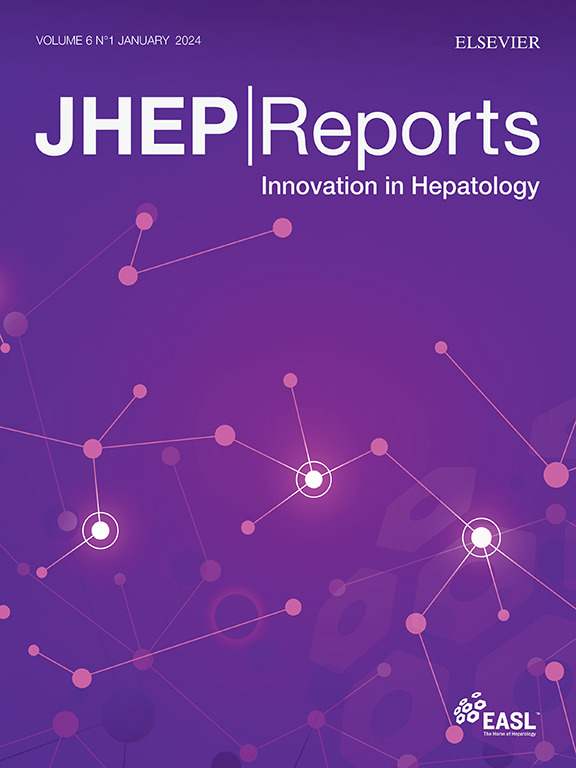适应性丙型肝炎病毒克隆感染先天免疫缺陷小鼠肝细胞与最小的人HCV进入因子
IF 9.5
1区 医学
Q1 GASTROENTEROLOGY & HEPATOLOGY
引用次数: 0
摘要
背景,目的丙型肝炎病毒(HCV)具有狭窄的种向性,不能感染小鼠。为了了解HCV的物种趋向性并建立更好的动物模型,我们使HCV感染先天免疫缺陷和人类HCV宿主因子最小的小鼠细胞。方法通过HCV感染病毒克隆在人肝癌细胞、小鼠肝细胞和最终在先天免疫缺陷、异位表达人occludin和人CD81的小鼠肝细胞中多次传代,使shcv适应。利用RNAseq分析了适应病毒的序列,并生成了几个克隆,以研究几种人/小鼠细胞系和人、小鼠和猕猴的原代肝细胞的复制和感染动力学以及中和试验。结果35个非同义突变和66个同义突变的积累与原代小鼠肝细胞感染性后代产量增加1000倍相关。这些突变不会产生耐药性或逃避先天免疫。它们并没有增强人类或猕猴肝细胞的适应性。我们表明,非同义突变是必要的和充分的适应,而改变糖蛋白是不必要的。病毒包膜蛋白外的突变增强了病毒的特异性感染性,促进了病毒在小鼠细胞中的传播。结论本研究揭示了控制HCV物种趋向性的关键病毒因子。小鼠适应的HCV为开发动物模型来分析HCV发病机制、免疫控制和疫苗开发开辟了可能性。影响和意义本工作原则上证明了HCV在非人类细胞中复制和感染的适应性。这可以通过数量可控的非同义突变来实现,并为阐明丙型肝炎病毒物种趋向性原理和为丙型肝炎病毒的长期研究开发重要的动物模型开辟了新的途径。本文章由计算机程序翻译,如有差异,请以英文原文为准。

Adapted hepatitis C virus clone infects innate immunity-deficient mouse hepatocytes with minimal human HCV entry factors
Background & Aims
Hepatitis C virus (HCV) has a narrow species tropism and cannot infect mice. To understand HCV species tropism and to develop better animal models, we adapted HCV to infect mouse cells deficient in innate immunity and with minimal human HCV host factors.
Methods
HCV was adapted via passaging an HCV infectious virus clone several times in human hepatoma cells, mouse liver cells, and eventually primary mouse hepatocytes deficient in innate immunity and ectopically expressing human occludin and human CD81. Using RNAseq the sequence of the adapted virus was analyzed, and several clones were generated to study replication and infection kinetics as well as neutralization assays in several human/mouse cell lines and primary hepatocytes from human, mouse, and macaques.
Results
Accumulation of 35 non-synonymous and 66 synonymous mutations correlated with >1,000-fold enhanced production of infectious progeny from primary mouse hepatocytes. These mutations did not confer drug resistance or evasion from innate immunity. They did not enhance fitness in human or macaque hepatocytes. We show that non-synonymous mutations are necessary and sufficient for adaptation, and that changes to the glycoproteins are not essential. Mutations outside of viral envelope proteins enhanced specific infectivity and facilitated viral spread in murine cells.
Conclusions
This study reveals key viral factors governing HCV species tropism. The mouse-adapted HCV opens up possibilities for the development of animal models to analyze HCV pathogenesis, immune control, and vaccine development.
Impact and implications
This work demonstrates the feasibility in principle of HCV adaptation to replication in and infection of non-human cells. This is made possible by a manageable number of non-synonymous mutations and opens up new ways to elucidate the principles of HCV species tropism and to develop important animal models for HCV research in the long term.
求助全文
通过发布文献求助,成功后即可免费获取论文全文。
去求助
来源期刊

JHEP Reports
GASTROENTEROLOGY & HEPATOLOGY-
CiteScore
12.40
自引率
2.40%
发文量
161
审稿时长
36 days
期刊介绍:
JHEP Reports is an open access journal that is affiliated with the European Association for the Study of the Liver (EASL). It serves as a companion journal to the highly respected Journal of Hepatology.
The primary objective of JHEP Reports is to publish original papers and reviews that contribute to the advancement of knowledge in the field of liver diseases. The journal covers a wide range of topics, including basic, translational, and clinical research. It also focuses on global issues in hepatology, with particular emphasis on areas such as clinical trials, novel diagnostics, precision medicine and therapeutics, cancer research, cellular and molecular studies, artificial intelligence, microbiome research, epidemiology, and cutting-edge technologies.
In summary, JHEP Reports is dedicated to promoting scientific discoveries and innovations in liver diseases through the publication of high-quality research papers and reviews covering various aspects of hepatology.
 求助内容:
求助内容: 应助结果提醒方式:
应助结果提醒方式:


